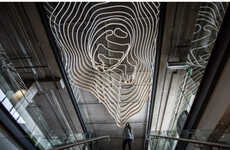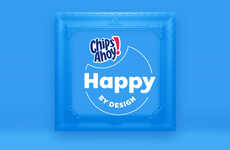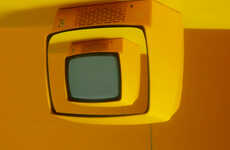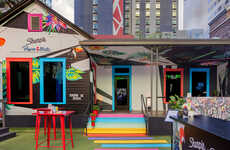
Tisah Tucknott — August 29, 2009 — Business
References: linkedin & pacodelatorre
As it states on his resume, Francisco (Pakko) De La Torre-Rocha is not only a leading Art Director, but he is also a Creative Madman and Sleep Hater. This creative genius has lived all over the world, including Brazil, Mexico and the United States.
Francisco (Pakko) De La Torre-Rocha is not only a multicultural man, he is also trilingual. Having worked for A+ list advertising agencies such as Saatchi & Saatchi, TBWA/CHIAT/DAY and Ogilvy & Mather, it is safe to say that Pakko is an extremely gifted individual.
13 Questions with Francisco (Pakko) De La Torre-Rocha
1. How do you keep your work on the cutting edge?
I must constantly consume many visual elements from around my world. Everyday I read, watch and listen to everything I can find on the web, magazines, movies, music, and outdoor life. When I find something interesting, I either bookmark it, take a picture of it or simply write it down in my idea book. I have this small Mead Composition notebook full of drawings, scribbles and notes that looks like I have been carrying it since high school, but it provides an excellent way for me to keep track of everything.
2. How do you reset yourself to become creative? Do you have any rituals?
I have developed my own automatic tools to refresh myself every morning. As soon as I wake up and have my first coffee in the morning at 7am, it all starts with a quick visit to my own blog. I have designed that site to automatically update itself using custom RSS scripts that seek content 10-14 times a day with ideas from many creative/ideas websites such as Trend Hunter, We Make Money Not Art, et cetera. I have also linked up my blog to automatically update my Facebook and Twitter updates, so they are always updated with fresh creative content that helps me stay freshly creative. Wherever I may be on the web—or on my iPhone—I am always bombarded with new ideas, new techniques, trends, etc. Everything [is] on autopilot.
3. What is an example of a time where you have thrown away an existing idea to force yourself to find something new?
When I was working at a boutique ad agency in L.A., there was an idea that I really wanted to utilize for a client’s brief. However, as time went on I found myself stuck in a creative dead end. The overall message with this idea of mine was weak, but the idea as a vehicle delivery method was amazing. I spent too much time trying to ‘fit’ this idea into the client’s brief—and when that happens, you risk ending up with a confusing message. As hard as it was, scrapping that idea and starting over—immediately solved the problem. A brand new concept arose—and the job was solved: in a matter of hours, too.
4. How did you get involved in art and what motivates you to continue?
Massive curiosity in all aspects of life is what got me started in art. As far as I can recall, I was always a very curious individual since I was a toddler. Everything around me was like a giant question mark—a “what if…”...a “how does that work…” to everything. I wanted to explore everything, touch everything, experiment non-stop. A great example was when I was 2 years old and living in dusty Torreon, Mexico with my family. Outside of my house back then, I climbed a 9 foot tall chain fence to sit on the edge of a brick wall—and then with a paint brush, I began to poke at a dangerous scorpion that was on also sitting on the edge. I can only imagine how my mother’s face turned pale as she saw me sitting on that 9 foot tall brick wall poking at that poisonous insect. In summary, by consistently thinking and wondering how things work—made me get into art. It’s not about how good one can draw or sculpt—it’s about being curious about everything. Art is the natural byproduct of extreme curiosity.
5. How significant are the topics of cool hunting and trend spotting in the world of art?
There are two ways I can comment on this. If one desires to work in the advertising world, it is of utmost importance to be able to keep up with cool hunting and trend hunting. We are in the business of selling products for our clients, and if one is not up to date with the latest in trends—you can be at risk of being completely out of touch with your consumers, and in the end, out of a job. If one desires to simply be an artist—perhaps in the world of fine arts—completely outside the influence of working in the advertising world - one can probably get away by not following trends. You simply carve your own path and create your own world and visual language.
6. How do you define a trend?
A trend is a crowd-sourced niche movement—one that is started by a either an individual or a select group of people. In most cases, they are always interesting without fully understanding why it is interesting in the first place. In most cases, people do not question ‘why is that the case?’ They just follow it and accept it and in most case, assimilate it into their consciousness and in some cases, into their lifestyles.
7. How do you define cool?
Defining what’s cool is a very personal thing. Sometimes, you just know when things are cool and not cool. What was cool two days ago may not be cool today. However, it’s important to realize that cool is a constant moving target. The way I utilize the term ‘cool’ in my career is to not immediately judge things right away and express what’s cool to other people. I usually take a bit of time try to see things outside of my own world, analysing what other people think before I deliver my own conclusion and set it into my work. It’s about being tolerant and patient before I try to use such ‘cool’ item into my work.
8. Do you need a culture of innovation to create something that is cool?
Not always. There are scenarios I have been in where the culture had zero sense of innovation but some great and original ideas were popping into my mind due to the restrictive surroundings. It’s almost as if a sense of revolution enters my mind and ideas forced themselves to be born under these difficult circumstances.
9. What is the best way to create an infectious idea, product or service?
I have found that the best way is to instil a very strong emotional touch point to your idea—the more emotional, the better. Humans by nature are very emotional creatures, and to make them remember things—one must create deep emotions embedded in ideas. I don’t think it matters whether it’s a sad, happy or angry emotion—humans will be destined to remember your idea no matter the emotion. Of course, it is favorable to ensure that such emotion you apply to your idea remains positive to make your clients happy.
10. What is the key to innovation?
In my own personal basis for my career, the main key to innovation is to constantly try to learn new skills from different areas outside of your work environment. If one is always focused in a single skill set from your work industry, you risk becoming a master of one single skill. 10 years ago, it may have been acceptable to be a person of a few but powerful skills. With today’s difficult economy and cut-throat competition, now it’s time to re-invent the term ‘Jack of all Trades’ and rename it into ‘Master of all Trades’.
11. What are the most important trends you see in the art industry?
Since I work in advertising, I am currently keeping my eyes focused on two areas/trends that I see developing rapidly in the next two years: Video Games and Virtual Concepts as message vehicles for ideas in advertising. The video game industry is quickly growing to tremendous heights, and it is due to continue doing so for the next few years. As for Virtual Concepts—it is the area that is dedicated to providing virtual reality, augmented reality and 3D Cinema/TV for the Virtual Generation. With the rapid evolution of smart phones such as the iPhone 3GS and next generation portable video game players such as PSP featuring cameras, this is a space to watch and to start thinking great big ideas.
12. Professionally, what do you want to be doing or studying in 10 years?
Ten years from now—I still want to work in advertising. But here is the twist: I want the agency to be inside a great boutique contemporary hotel, owned by me. I love the hospitality industry, and if I could run the agency inside such hotel—it would be golden for me. Imagine having all the fine amenities of such hotel, available to everyone in the agency as well as any guest. Oh, and this hotel – it would be in located on the beach in Puerto Vallarta, Mexico. Golden.
13. What are your most important hobbies?
Besides creating new ideas….I always find myself customizing things such as open source games, Photoshop brushes, website designs, music remixes. I also try to create new mash-ups of existing ideas into one big idea that could be more powerful. On the entertainment side, I have found myself trying Easter eggs on video games, reading obscure and weird books from other countries, finding niche sites on the web about obscure and wonderful topics…and trend hunting for the next big thing.
To follow the fascinating work of Francisco (Pakko) De La Torre-Rocha, look for him at the links below as well as at Facebook and MySpace.
Francisco (Pakko) De La Torre-Rocha is not only a multicultural man, he is also trilingual. Having worked for A+ list advertising agencies such as Saatchi & Saatchi, TBWA/CHIAT/DAY and Ogilvy & Mather, it is safe to say that Pakko is an extremely gifted individual.
13 Questions with Francisco (Pakko) De La Torre-Rocha
1. How do you keep your work on the cutting edge?
I must constantly consume many visual elements from around my world. Everyday I read, watch and listen to everything I can find on the web, magazines, movies, music, and outdoor life. When I find something interesting, I either bookmark it, take a picture of it or simply write it down in my idea book. I have this small Mead Composition notebook full of drawings, scribbles and notes that looks like I have been carrying it since high school, but it provides an excellent way for me to keep track of everything.
2. How do you reset yourself to become creative? Do you have any rituals?
I have developed my own automatic tools to refresh myself every morning. As soon as I wake up and have my first coffee in the morning at 7am, it all starts with a quick visit to my own blog. I have designed that site to automatically update itself using custom RSS scripts that seek content 10-14 times a day with ideas from many creative/ideas websites such as Trend Hunter, We Make Money Not Art, et cetera. I have also linked up my blog to automatically update my Facebook and Twitter updates, so they are always updated with fresh creative content that helps me stay freshly creative. Wherever I may be on the web—or on my iPhone—I am always bombarded with new ideas, new techniques, trends, etc. Everything [is] on autopilot.
3. What is an example of a time where you have thrown away an existing idea to force yourself to find something new?
When I was working at a boutique ad agency in L.A., there was an idea that I really wanted to utilize for a client’s brief. However, as time went on I found myself stuck in a creative dead end. The overall message with this idea of mine was weak, but the idea as a vehicle delivery method was amazing. I spent too much time trying to ‘fit’ this idea into the client’s brief—and when that happens, you risk ending up with a confusing message. As hard as it was, scrapping that idea and starting over—immediately solved the problem. A brand new concept arose—and the job was solved: in a matter of hours, too.
4. How did you get involved in art and what motivates you to continue?
Massive curiosity in all aspects of life is what got me started in art. As far as I can recall, I was always a very curious individual since I was a toddler. Everything around me was like a giant question mark—a “what if…”...a “how does that work…” to everything. I wanted to explore everything, touch everything, experiment non-stop. A great example was when I was 2 years old and living in dusty Torreon, Mexico with my family. Outside of my house back then, I climbed a 9 foot tall chain fence to sit on the edge of a brick wall—and then with a paint brush, I began to poke at a dangerous scorpion that was on also sitting on the edge. I can only imagine how my mother’s face turned pale as she saw me sitting on that 9 foot tall brick wall poking at that poisonous insect. In summary, by consistently thinking and wondering how things work—made me get into art. It’s not about how good one can draw or sculpt—it’s about being curious about everything. Art is the natural byproduct of extreme curiosity.
5. How significant are the topics of cool hunting and trend spotting in the world of art?
There are two ways I can comment on this. If one desires to work in the advertising world, it is of utmost importance to be able to keep up with cool hunting and trend hunting. We are in the business of selling products for our clients, and if one is not up to date with the latest in trends—you can be at risk of being completely out of touch with your consumers, and in the end, out of a job. If one desires to simply be an artist—perhaps in the world of fine arts—completely outside the influence of working in the advertising world - one can probably get away by not following trends. You simply carve your own path and create your own world and visual language.
6. How do you define a trend?
A trend is a crowd-sourced niche movement—one that is started by a either an individual or a select group of people. In most cases, they are always interesting without fully understanding why it is interesting in the first place. In most cases, people do not question ‘why is that the case?’ They just follow it and accept it and in most case, assimilate it into their consciousness and in some cases, into their lifestyles.
7. How do you define cool?
Defining what’s cool is a very personal thing. Sometimes, you just know when things are cool and not cool. What was cool two days ago may not be cool today. However, it’s important to realize that cool is a constant moving target. The way I utilize the term ‘cool’ in my career is to not immediately judge things right away and express what’s cool to other people. I usually take a bit of time try to see things outside of my own world, analysing what other people think before I deliver my own conclusion and set it into my work. It’s about being tolerant and patient before I try to use such ‘cool’ item into my work.
8. Do you need a culture of innovation to create something that is cool?
Not always. There are scenarios I have been in where the culture had zero sense of innovation but some great and original ideas were popping into my mind due to the restrictive surroundings. It’s almost as if a sense of revolution enters my mind and ideas forced themselves to be born under these difficult circumstances.
9. What is the best way to create an infectious idea, product or service?
I have found that the best way is to instil a very strong emotional touch point to your idea—the more emotional, the better. Humans by nature are very emotional creatures, and to make them remember things—one must create deep emotions embedded in ideas. I don’t think it matters whether it’s a sad, happy or angry emotion—humans will be destined to remember your idea no matter the emotion. Of course, it is favorable to ensure that such emotion you apply to your idea remains positive to make your clients happy.
10. What is the key to innovation?
In my own personal basis for my career, the main key to innovation is to constantly try to learn new skills from different areas outside of your work environment. If one is always focused in a single skill set from your work industry, you risk becoming a master of one single skill. 10 years ago, it may have been acceptable to be a person of a few but powerful skills. With today’s difficult economy and cut-throat competition, now it’s time to re-invent the term ‘Jack of all Trades’ and rename it into ‘Master of all Trades’.
11. What are the most important trends you see in the art industry?
Since I work in advertising, I am currently keeping my eyes focused on two areas/trends that I see developing rapidly in the next two years: Video Games and Virtual Concepts as message vehicles for ideas in advertising. The video game industry is quickly growing to tremendous heights, and it is due to continue doing so for the next few years. As for Virtual Concepts—it is the area that is dedicated to providing virtual reality, augmented reality and 3D Cinema/TV for the Virtual Generation. With the rapid evolution of smart phones such as the iPhone 3GS and next generation portable video game players such as PSP featuring cameras, this is a space to watch and to start thinking great big ideas.
12. Professionally, what do you want to be doing or studying in 10 years?
Ten years from now—I still want to work in advertising. But here is the twist: I want the agency to be inside a great boutique contemporary hotel, owned by me. I love the hospitality industry, and if I could run the agency inside such hotel—it would be golden for me. Imagine having all the fine amenities of such hotel, available to everyone in the agency as well as any guest. Oh, and this hotel – it would be in located on the beach in Puerto Vallarta, Mexico. Golden.
13. What are your most important hobbies?
Besides creating new ideas….I always find myself customizing things such as open source games, Photoshop brushes, website designs, music remixes. I also try to create new mash-ups of existing ideas into one big idea that could be more powerful. On the entertainment side, I have found myself trying Easter eggs on video games, reading obscure and weird books from other countries, finding niche sites on the web about obscure and wonderful topics…and trend hunting for the next big thing.
To follow the fascinating work of Francisco (Pakko) De La Torre-Rocha, look for him at the links below as well as at Facebook and MySpace.
Trend Themes
1. Multiculturalism - Disruptive innovation opportunity: Creating advertising campaigns that resonate with diverse audiences and celebrate cultural diversity.
2. Virtual Reality - Disruptive innovation opportunity: Developing immersive virtual reality experiences for advertising and marketing campaigns that captivate consumers.
3. Trend Hunting - Disruptive innovation opportunity: Building data-driven algorithms and tools to gather and analyze trends for advertising agencies and brands to stay ahead of the curve.
Industry Implications
1. Advertising - Disruptive innovation opportunity: Exploring new ways of storytelling and engaging consumers through advanced technologies and creative approaches.
2. Hospitality - Disruptive innovation opportunity: Integrating advertising agencies into boutique contemporary hotels to create unique and immersive experiences for clients and employees.
3. Video Game - Disruptive innovation opportunity: Collaborating with video game developers to create interactive and engaging advertising campaigns within virtual worlds and gaming platforms.
4.1
Score
Popularity
Activity
Freshness























